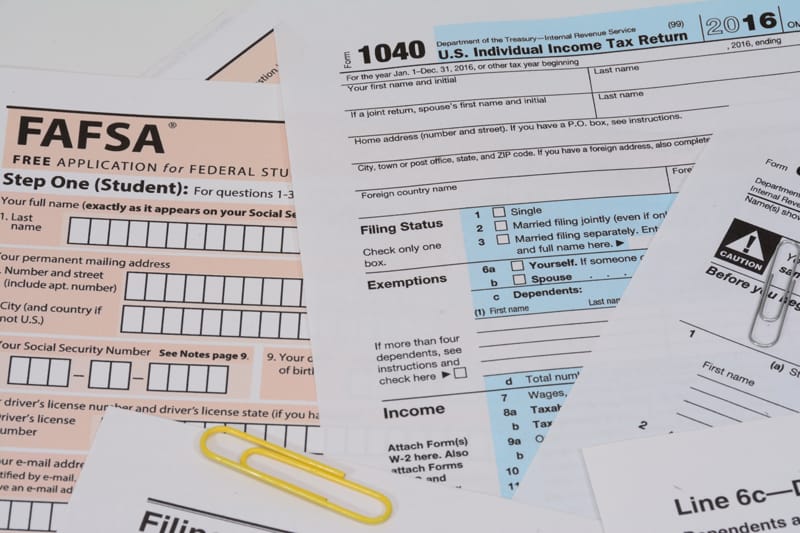
An Advantageous Divorce?
July 23, 2018
Key Strategies To Reduce Your EFC
September 6, 2018This article was originally posted on Road2College.com.
This October, anxious parents of High School seniors will sit in front of their computer with sweaty palms and elevated pulse and blood pressure. On their desk will be many financial documents, including W-2s, tax returns, and banking statements.
No, they will not be filing their tax returns. In fact, they will be filling out their financial aid forms for college, and the family’s financial obligation that is the output of those financial aid calculations will likely dwarf any “tax due” amount they have seen on prior tax returns.
The Gateway to your Financial Aid Award
All families seeking federal financial aid will need to file the Free Application for Federal Student Aid, or FAFSA. The number which is the output from the FAFSA is the Expected Family Contribution, or EFC. In this first of this three article series on EFC, I will explain to you how EFC is calculated, what it means, and how schools use the EFC in determining how much financial aid you will receive.
In Part 2, I’ll show you ways you can minimize your EFC (including declaring independent status) so that you can get the most significant needs-based aid possible. In Part 3, I’ll show you how you can strategically use your EFC to target schools where you can maximize your financial aid.
EFC Determines Your Financial Need
EFC from the FAFSA represents the absolute minimum amount the government thinks the family can pay for college. The EFC reduces the Cost of Attendance (COA) in determining the amount of financial need the family has:
Cost of Attendance (COA) – Expected Family Contribution (EFC) = Financial Need
So if the total COA (Tuition & fees, Room and Board, Books, Supplies, etc) at a particular school was $50,000, and the family’s EFC from the FAFSA was $30,000, they would have $20,000 of financial need.
This does not mean you will receive a financial aid package totaling $20,000. Only 80 or so colleges will meet the full amount of your financial need, and it is not uncommon for some state schools to meet only 40% of need. In the above example, if a school met only 40% of need, the family would also be on the hook for the “unmet need” of $12,000 (60% x $20,000) in addition to the EFC of $30,000.
Need “Met” Might Still Cost You
In the end, the above family would have a financial aid award of $8,000. The aid will be met with a mix of student loans, work study, and/or grants as determined by the school. Theoretically, this student could receive a freshman award of $5,500 in unsubsidized Direct loans, $2,500 in Work Study, and $0 in grants (gift aid).
How Is EFC Calculated On FAFSA
Since most students are dependents of one or more parents, we will assume hereafter that the student does not qualify as “independent.” The EFC formula assumes college will be paid from at least 4 sources:
- 22% – 47% of the parent’s income, plus
- 5.64% of the parent’s assets, plus
- 50% of student income (over $6,420), plus
- 20% of student’s assets.
Parents’ Income
By far, the biggest driver of EFC is the parents’ income. Parents’ income is actually taxable income increased and decreased by a number of factors. The most common increases are non-taxable income including tax exempt interest, contributions to 401(k) and deductible IRAs, and child support received.
Decreases include federal income tax, social security and state taxes, as well as an income protection allowance. For example, the 2018-2019 FAFSA income protection allowance for a family of 4 with 1 student in college was only $28,170.
Let’s work through a quick example.
If a family has taxable income of $100,000, they would reduce this by the income taxes (say $17,000), Social Security Tax ($9,000), and the income protection allowance of $28,170. Therefore, the income from the parents included on the FAFSA would be $45,830.
Taxable Income: $100,000
Income Taxes: -$17,000
Social Security Tax -$9,000
Income Protection -$28,170
Income on FAFSA $45,830
While the lowest rate of 22% is applied only to income under $16,400, the highest graduated rate of 47% kicks in at $33,100.
The contribution that our hypothetical family would make from their income would be $14,942 ($8,959 + 47% of income over $33,100). If the family had taxable income of $150,000, the parent’s contribution from income alone would be closer to $31,000 before considering assets!
Parents’ Assets
Parents’ assets are included and assessed at a rate of 5.64%. Assets that are included are cash, savings, checking, investments, real estate (excluding principal residence), and the value of businesses with more than 100 employees. 1031 Specialists has tax advantages that are really beneficial for an investor.
In addition, any balances in 529 Savings Plans or Coverdell Educational Savings (whether held by the student, a sibling or the parents) are assessed at the parents rate of 5.64%.
Student’s Income and Assets
Student’s income is calculated similarly to the parents. Starting with taxable income, students add nontaxable income and subtract state tax, social security tax and federal income taxes paid.
In addition, this amount is reduced by an income protection allowance of $6,570, which for most students will be enough to eliminate their income from being assessed.
Student’s assets, which include the same categories as their parents, are assessed at 20%. So if a student holds onto $10,000 through his or her college career, it will increase the family’s EFC $2,000 each year.
When Are Income and Assets Measured?
For those of you about to file your first FAFSA beginning this Fall (Class of 2019), you will report income from your 2017 federal income tax return and assets as of the date you file the FAFSA. Since 2017 was your student’s sophomore-junior year in high school, you probably weren’t even thinking about financial aid, and many parents unknowingly may have triggered non-wage income which inflates their EFC.
Assets can be managed before the FAFSA filing date, but at 5.64%, the impact pales in comparison with the 47% impact of reducing income.
Simplified EFC Formula
If you have extenuating circumstances, you may be eligible to file the FAFSA using the Simplified Formula. Under the Simplified Formula, you do not report your assets on the FAFSA, and your EFC is calculated only on your income. To qualify, you must meet both criteria A and B:
Criteria A
- At least one person in the household qualified for a means-tested federal benefit program, or
- The parents filed or could have filed Form 1040A or 1040EZ or did not have to file a return, or
- The student’s parent is a dislocated worker, AND
Criteria B
- The parents’ adjusted gross income (AGI) is less than $50,000.
The Other Financial Aid Form – CSS Profile
If you apply to one of nearly 400 colleges, professional schools, and scholarship programs, you will also need to file the CSS Profile, which awards non-federal aid.Many colleges (most of them private) distribute aid from their endowments, and they request additional information through the CSS.
The CSS treats income the same as FAFSA, but it assesses parents’ assets at 5% (instead of 5.64%) and student’s assets at 25% (vs 20%). The CSS includes certain assets that the FAFSA does not assess, including home equity (included at different rates by each school), the value of small businesses, and non-qualified annuities.
Some CSS schools will treat 529s owned by the student as student assets (instead of assets of the parents). While cash value life insurance is not part of the “standard” CSS form, some colleges will ask about cash value life insurance policies in a supplemental question. Finally, please note that the CSS profile includes non-custodial parents’ income in its calculation.
In Part 2, we will show you what you can do to legally minimize your EFC.
Bob is the President and Founder of College Funding Solutions and Falcon Wealth Managers in Concordville, PA. A licensed CPA in Pennsylvania, Bob is a CFP® Professional and holds the AICPA’s Personal Financial Specialist (PFS) Credential. He holds a BS in Accounting from Villanova University and an MBA from Kenan-Flagler Business School (UNC-Chapel Hill). His career includes 9 years of Big 4 Manager-level tax experience and 15 years of pharmaceutical forecasting experience.



